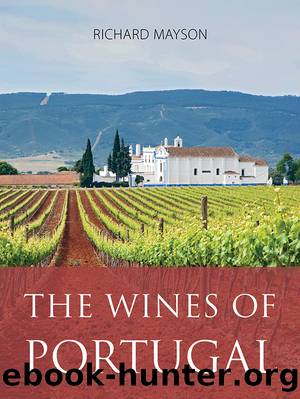The Wines of Portugal by Richard Mayson

Author:Richard Mayson
Language: eng
Format: epub
Publisher: Infinite Ideas Limited
Colares: pines, vines and sand
Styles of wine
Three different types of wine are permitted to use the name Colares: two styles of red and one white. The most highly prized Colares comes exclusively from the chão de areia. Here, the Ramisco grape must make up at least 80 per cent of the blend, giving true Colares its perfumed raspberry and morello cherry character. Other varieties (mostly Castelão, Parreira Matias and Tinta Miuda) may be added to fill out the blend. The wines are austere and tannic when young and it was customary to give them time in bottle (at least ten years) to shed their initial astringency. From the 1970s to the early 2000s Colares was so lean and stringent in style that the fruit frequently dried up before the tannins had softened. A vertical tasting of Colares organized by Dirk Niepoort in 2001 revealed wines from the 1960s, 1950s and 1940s that were still in good condition, with characteristically perfumed aromas, linear tannins and some enticingly fine but fragile fruit remaining. A 1965 âCollaresâ from Viuva Gomes tasted in 2019 is one of the most haunting wines that I have drunk in recent years: high-toned but fragrant, with wild berry aromas and fresh, characteristically astringent raspberry fruit flavours, still elegant and suave despite the obvious acidity which had kept the wines alive. In their day D. J. Silva, Paulo da Silva âChitasâ and Viúva Gomes all bottled Colares wines to a high standard.
A small quantity of a second and less esteemed red wine comes from the chão rijo on the largely calcareous soils away from the coast. These are heavier, sturdy wines made from a number of more productive grapes than the low yielding Ramisco. Blending them with the chão de areia wines is still technically forbidden but they may occasionally be bottled under a separate label with the designation âColares-Chão Rijoâ. White wines come from the elusive Malvasia de Colares grape. In the past these were typically oxidized and lacking in freshness but both the Adega Regional and Casal Santa Maria are now working wonders and there is nowhere better to enjoy the lemon and herb flavours of a good white Colares than at one of the beachside restaurants serving fresh fish on this stretch of Atlantic coast.
Producers
The bulk of Colares is still produced by the Adega Regional, whose production methods have improved greatly over the past decade. It is open to visitors though much of the cavernous nineteenth-century building is empty and used as an auditorium for summer concerts. The local legislation specifies a minimum ageing requirement of at least 18 months for reds and 6 months for whites; this traditionally took place in old oak ranging in size from four to fourteen thousand litres. The wines are either bottled in situ or returned to the grower who delivered the grapes to the Adega Regional at the outset. A number of firms associated with Colares are now history: D. J. Silva, Tavares & Rodrigues and Visconde de Salreu no longer exist but old bottles of their wines can still be found.
Download
This site does not store any files on its server. We only index and link to content provided by other sites. Please contact the content providers to delete copyright contents if any and email us, we'll remove relevant links or contents immediately.
Life 3.0: Being Human in the Age of Artificial Intelligence by Tegmark Max(5475)
The Sports Rules Book by Human Kinetics(4296)
The Age of Surveillance Capitalism by Shoshana Zuboff(4213)
ACT Math For Dummies by Zegarelli Mark(3996)
Unlabel: Selling You Without Selling Out by Marc Ecko(3591)
Blood, Sweat, and Pixels by Jason Schreier(3566)
Hidden Persuasion: 33 psychological influence techniques in advertising by Marc Andrews & Matthijs van Leeuwen & Rick van Baaren(3474)
The Pixar Touch by David A. Price(3364)
Bad Pharma by Ben Goldacre(3357)
Urban Outlaw by Magnus Walker(3342)
Project Animal Farm: An Accidental Journey into the Secret World of Farming and the Truth About Our Food by Sonia Faruqi(3178)
Kitchen confidential by Anthony Bourdain(3010)
Brotopia by Emily Chang(3001)
Slugfest by Reed Tucker(2942)
The Content Trap by Bharat Anand(2863)
The Airbnb Story by Leigh Gallagher(2800)
Coffee for One by KJ Fallon(2567)
Smuggler's Cove: Exotic Cocktails, Rum, and the Cult of Tiki by Martin Cate & Rebecca Cate(2473)
Beer is proof God loves us by Charles W. Bamforth(2374)
